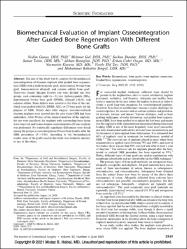| dc.contributor.author | Güneş, Nedim | |
| dc.contributor.author | Gül, Mehmet | |
| dc.contributor.author | Dündar, Serkan | |
| dc.contributor.author | Tekin, Samet | |
| dc.contributor.author | Bozoğlan, Alihan | |
| dc.contributor.author | Özcan, Erhan Cahit | |
| dc.contributor.author | Karasu, Necmettin | |
| dc.contributor.author | Toy, Vesile Elif | |
| dc.contributor.author | Bingül, Muhammet Bahattin | |
| dc.date.accessioned | 2022-05-26T09:44:30Z | |
| dc.date.available | 2022-05-26T09:44:30Z | |
| dc.date.issued | 2021 | en_US |
| dc.identifier.citation | Gunes, N., Gul, M., Dundar, S., Tekin, S., Bozoglan, A., Ozcan, E. C., ... & Bingül, M. B. (2021). Biomechanical evaluation of implant osseointegration after guided bone regeneration with different bone grafts. Journal of Craniofacial Surgery, 32(4), 1545-1548. | en_US |
| dc.identifier.issn | 1536-3732 | |
| dc.identifier.uri | https://doi.org/10.1097/SCS.0000000000007102 | |
| dc.identifier.uri | https://hdl.handle.net/20.500.12933/1090 | |
| dc.description.abstract | The aim of this study was to compare the biomechanical osseointegration of titanium implants after guided bone regeneration (GBR) with a hydroxyapatite graft, deproteinized bovine bone graft, human-derived allograft, and calcium sulfate bone graft. Thirty-two female Sprague Dawley rats were divided into four groups, each containing eight (n = 8) rats: hydroxyapatide (HA), deproteinized bovine bone graft (DPBB), allograft (ALG), and calcium sulfate. Bone defects were created in the tibia of the rats, which were grafted with HA, DPBB, ALG, or CP bone grafts for the purpose of GBR. Ninety days after surgery, machine-surfaced titanium implants were inserted into the area where GBR had been undertaken. After 90 days of the surgical insertion of the implants, the rats were sacrificed, the implants with surrounding bone tissue were removed, and biomechanical osseointegration (N/cm) analysis was performed. No statistically significant differences were found among the groups in osseointegration (N/cm) three months after the GBR procedures (P > 0.05). According to the biomechanical results, none of the grafts used in this study was distinctly superior to any of the others. | en_US |
| dc.language.iso | eng | en_US |
| dc.publisher | Lippincott, Williams & Wilkins | en_US |
| dc.relation.isversionof | 10.1097/SCS.0000000000007102 | en_US |
| dc.rights | info:eu-repo/semantics/embargoedAccess | en_US |
| dc.subject | Biomechanic | en_US |
| dc.subject | Bone grafts | en_US |
| dc.subject | Bone implant connection | en_US |
| dc.subject | Guided bone regeneration | en_US |
| dc.subject | Osseointegration | en_US |
| dc.title | Biomechanical Evaluation of Implant Osseointegration After Guided Bone Regeneration With Different Bone Grafts | en_US |
| dc.type | article | en_US |
| dc.authorid | 0000-0003-0388-5767 | en_US |
| dc.department | AFSÜ, Tıp Fakültesi, Cerrahi Tıp Bilimleri Bölümü, Plastik Rekonstrüktif ve Estetik Cerrahi | en_US |
| dc.contributor.institutionauthor | Karasu, Necmettin | |
| dc.identifier.volume | 32 | en_US |
| dc.identifier.issue | 4 | en_US |
| dc.identifier.startpage | 1545 | en_US |
| dc.identifier.endpage | 1548 | en_US |
| dc.relation.journal | Journal of Craniofacial Surgery | en_US |
| dc.relation.publicationcategory | Makale - Uluslararası Hakemli Dergi - Kurum Öğretim Elemanı | en_US |
















